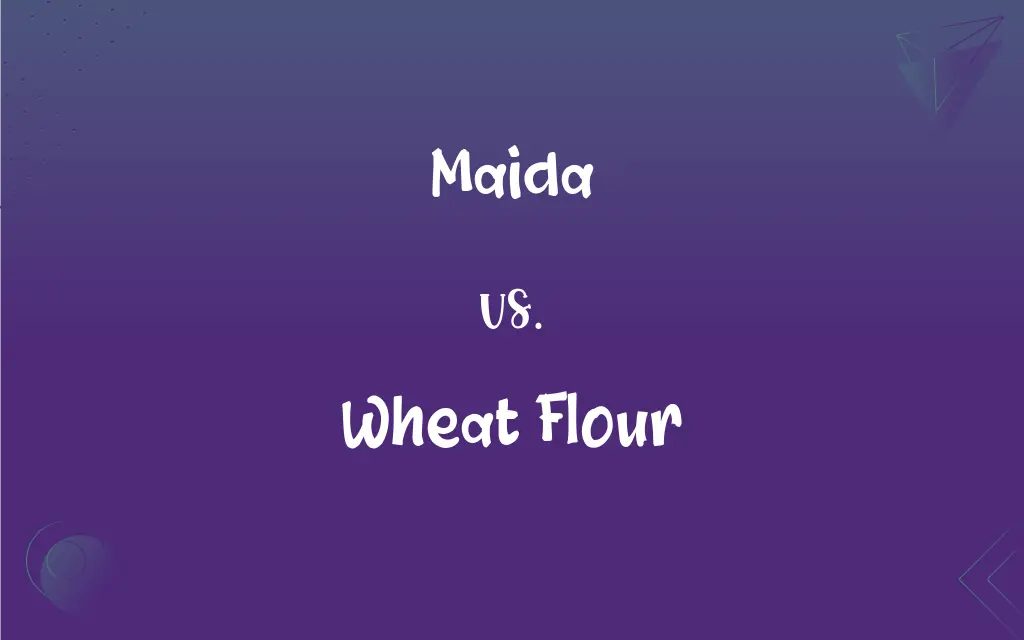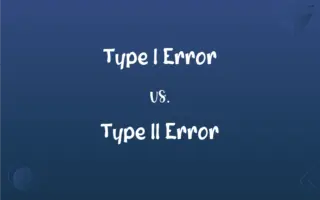Maida vs. Wheat Flour: What's the Difference?
Edited by Aimie Carlson || By Janet White || Published on February 2, 2024
Maida is a finely milled, refined, and bleached wheat flour used for its soft texture, while wheat flour, typically whole wheat, retains bran and germ, offering a coarser texture and higher nutritional content.

Key Differences
Maida is made from the endosperm of wheat grains, refined and bleached, resulting in a white, fine flour. Wheat flour, especially whole wheat, is made from the entire wheat grain, including bran and germ, leading to a coarser, more nutritious flour.
Maida is lower in fiber and nutrients due to the removal of bran and germ during processing. Wheat flour, particularly whole wheat, is richer in fiber, vitamins, and minerals due to the retention of all parts of the grain.
Maida is commonly used in baking and for making fine-textured bread and pastries. Wheat flour is versatile, used in bread, baked goods, and other recipes where a heartier texture is desired.
Regular consumption of maida may lead to health concerns due to its lower nutritional value and higher glycemic index. Wheat flour is generally considered healthier, offering more dietary fiber and a lower glycemic index.
Maida has a very fine, soft texture and yields a softer, lighter product in baking. Wheat flour, particularly whole wheat, has a rougher texture and gives a denser, more substantial feel to baked goods.
ADVERTISEMENT
Comparison Chart
Processing
Refined, bleached, endosperm only
Whole grain, includes bran and germ
Nutritional Value
Lower in fiber, vitamins, minerals
Higher in fiber, vitamins, minerals
Culinary Uses
Fine-textured bread, pastries
Hearty bread, versatile baking uses
Health Implications
Lower nutritional value
Healthier, more dietary fiber
Physical Characteristics
Fine, soft texture
Coarser, more substantial texture
ADVERTISEMENT
Maida and Wheat Flour Definitions
Maida
A bleached flour creating light and airy baked goods.
The maida resulted in exceptionally light pastry layers.
Wheat Flour
Suitable for whole grain baked goods and healthier recipes.
I switched to wheat flour for a healthier pizza crust.
Maida
A common flour in Indian cuisine for bread like naan and paratha.
For dinner, I prepared parathas using maida.
Wheat Flour
A flour made from whole wheat grains, retaining bran and germ.
I baked a hearty loaf of bread with wheat flour.
Maida
A finely milled, refined wheat flour used in baking.
I used maida to bake a soft, fluffy cake.
Wheat Flour
Has a coarser texture and is used in traditional bread making.
The wheat flour gave the bread a robust texture.
Maida
Low in fiber and nutrients due to the refining process.
Maida is less nutritious than whole wheat flour.
Wheat Flour
Nutrient-rich with a higher fiber content.
Using wheat flour adds more fiber to our diet.
Maida
Preferred for its smooth texture in confectionery.
The maida gave the cookies a delicate, fine crumb.
Wheat Flour
A staple in many kitchens for its versatility and nutrition.
Wheat flour is my go-to for most baking needs.
Maida
A finely milled, refined and bleached wheat flour, used in making many Indian foods like samosa, chakli and bhatoora.
FAQs
Why is wheat flour considered better for health?
Wheat flour retains more nutrients and fiber, especially in its whole grain form.
What is wheat flour?
Wheat flour is made from whole or part of the wheat grain and can range from refined to whole grain.
Can maida be substituted with wheat flour in recipes?
Yes, but it may alter the texture and nutritional content of the dish.
Can maida be fortified?
Yes, it is often fortified with vitamins and minerals.
What is maida?
Maida is a finely milled, refined, and bleached wheat flour, common in South Asian cuisine.
Is maida healthy?
Maida is lower in nutrients and fiber compared to whole wheat flour, making it less healthy.
Is maida good for baking?
Yes, maida is excellent for baking due to its fine texture and ability to create light, fluffy products.
Is wheat flour suitable for people with gluten intolerance?
No, as it contains gluten.
Can maida be used for making pasta?
Yes, it can be used but is not the traditional choice.
Can wheat flour be used for making Indian breads like naan?
Yes, though the texture will be heartier compared to using maida.
Does maida have a higher glycemic index than wheat flour?
Yes, maida typically has a higher glycemic index.
Is wheat flour more environmentally friendly?
Generally, yes, as it requires less processing.
How long can wheat flour be stored?
Properly stored, it can last several months.
Is wheat flour gluten-free?
No, wheat flour contains gluten.
Is maida vegan?
Yes, it is vegan.
Can wheat flour be used in making cakes?
Yes, but the texture will be denser than with maida.
Does maida contain preservatives?
It can contain preservatives, depending on the brand.
Is wheat flour better for weight management?
Yes, due to its higher fiber content, it can be better for weight management.
Can maida cause digestive issues?
Yes, for some people, due to its low fiber content.
Can maida be used in thickening sauces?
Yes, it is commonly used as a thickener in sauces and gravies.
About Author
Written by
Janet WhiteJanet White has been an esteemed writer and blogger for Difference Wiki. Holding a Master's degree in Science and Medical Journalism from the prestigious Boston University, she has consistently demonstrated her expertise and passion for her field. When she's not immersed in her work, Janet relishes her time exercising, delving into a good book, and cherishing moments with friends and family.
Edited by
Aimie CarlsonAimie Carlson, holding a master's degree in English literature, is a fervent English language enthusiast. She lends her writing talents to Difference Wiki, a prominent website that specializes in comparisons, offering readers insightful analyses that both captivate and inform.
































































